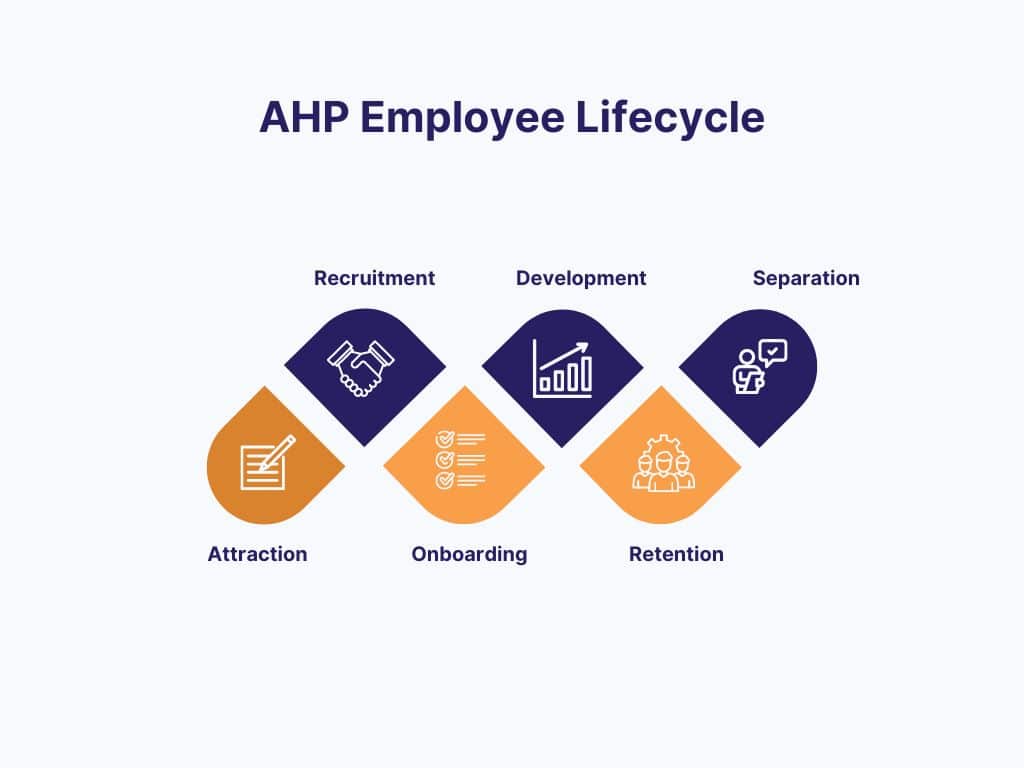
The Allied Health Employee Lifecycle: Optimising Allied Health Recruitment and Retention
If you are struggling to recruit allied health staff, then you are not alone. The employment market is tight in all sectors and in many countries, but the allied health professions have the dubious honor of filling several of the top 10 hardest to recruit roles in Australia, according to Seek.com.au.
When workers are scarce, employers start to focus on their approaches to recruitment. However, if there is a lack of workforce supply, then it can be too late to think about your recruitment approach.
Ideally, you will always have adequate staff to meet your ongoing workforce requirements, working to both meet the needs of your organisation and use their own skills to the best of their ability. This means planning for the full life cycle of your employees, not just filling gaps when staff leave.
The allied health employee lifecycle approach
There are various iterations of the employee life cycle approach. The basic premise is that you consider the whole journey of any potential employee from potentially before they even choose to enter your profession until they leave your employment. The Allied Health Employee Life Cycle incorporates the important period of attraction – potentially before someone has even considered entering your profession, recruitment, onboarding, development/retention, and then separation. These are explored in more detail below and in subsequent (linked) articles.
1. Attraction
The days of being able to start your recruitment process at the same time as you have a job vacancy disappeared with world peace and cheap coffee. A quick skim through the job advertisements for any allied health profession will show you that it is well and truly an employee’s market right now. That means that if you enter the job market, you are entering a highly competitive process and you need to be able to differentiate yourself from the rest of the employers—in a way that will appeal to potential new recruits.

There are three principles to consider in employee attraction:
Have a clear value proposition
What is it that you, or your workplace offers that makes it a great place to work? This should include your values and client focus, the value you add to your clients and/or community—perhaps the opportunities for innovation or to do new and amazing things—a particular focus on diversity, and maybe your location offers some lifestyle advantages. If you don’t already have a clear value proposition, now is the time to develop it. Look at your colleagues and competitors to see how they frame their value proposition. This should be clearly articulated on your website and in any job advertisements.
Be a place that people want to work
Approaches to employee attraction increasingly focus on workplaces striving to be an employer of choice. An employer of choice builds and nurtures their workplace in a way that attracts and retains the most talented and committed employees. There is no ‘cookie-cutter’ approach to being an employer of choice, however there are a number of examples of employers of choice within the health, aged care, disability and social care sectors which are a valuable place to benchmark. Concepts that can help to differentiate you as an employer of choice include a focus on inclusion and diversity, a commitment to environmental sustainability, giving back (e.g., volunteering or being part of a community giving scheme), and lifestyle benefits (gym membership, idyllic environment).
You are always recruiting
Instead of starting to think about recruitment from the time you have a vacancy in your workforce, you should consider that you are always trying to attract the best staff to work with you. You are an ambassador for your organisation and for your profession. If you want to attract the brightest and best to work with you, you need to promote yourself, your organisation and your profession to prospective recruits.
Many allied health professionals are attracted to the profession because of their personal experiences with particular types of therapists. Similarly, one of the greatest sources of recruitment reported both by new graduates and employers is student placements during training.
Your website also needs to not just be client facing, but employee facing. Increasingly, employers (large and small) have web pages dedicated to future employees, promoting the benefits of working with that employer group.
2. Recruitment
The recruitment process is often reduced to the production of a position description and a few lines scribbled down as an advertisement. A quick glance at a job advertisement website will show the enormous variation in the way employers present their role. You have three lines of text to enable your advertisement to stand out from possibly 5,000 others in your profession. While a competitive salary is important, a number of other features are valued more highly by prospective recruits, including career development opportunities, mentorship and support, and lifestyle benefits, including flexible working.
Be clear about your value proposition and try to promote that to prospective employees. Dr Cath Cosgrave developed the Health Workforce Recruiter Connector model which provides a whole of person approach to recruitment and retention.
A more detailed description of recruitment strategies, attractors and detractors is available here.
3. Onboarding

Senior allied health roles tend to be the most challenging to fill—regardless of the profession, therefore there is a good chance that you will need to employ one or more new graduates in your workplace. The current cohort of graduates have studied during two years of COVID-19, which means that their clinical placements, training and normal study routines have been interrupted. Even in ‘normal’ (non-COVID-19) times, it takes time to get new staff, and particularly new graduates up to speed so they can work as effectively and efficiently in your practice. Lack of work readiness is one of the biggest challenges that employers cite when employing new graduates.
A good onboarding program provides a structured approach to support and prepare your worker to be as productive as possible as quickly as possible. It includes a clear job description, clarity of expectations, access to support and training, and details of the organisational culture and practices.
See our seven-step onboarding process described here.
4. Retention

Recruiting good staff is just the beginning of their journey with you as an employer. There is a good chance that you will have spent up to 12 months attempting to recruit your new staff member and made between 5 and 10 offers to prospective employees before you actually have someone sign on the dotted line. The costs of recruiting are typically 30% or more of the salary of the worker you are employing—probably more in this tight employment market.
All of these are good reasons to ensure that you hang onto your staff for as long as possible.
Retention is more than just good luck. It also requires good management. Ensure you have the right structures in place to support the retention of your staff, including a positive organisational culture, flexibiltiy to support diverse needs, structures to provide feedback, monitoring of performance and progress, and recognition of a contribution to organisational goals. Poor performance should be managed quickly and well. More information about retention can be found here.
5. Development
One of the most highly cited challenges for allied health professionals—across all disciplines—is the lack of career development opportunities in allied health. If your goal is to retain your employee for at least three years, then ensure that you have an explicit growth strategy for your team that will support their development over that time. The growth of your employees should align with your organisational goals, and include the appropriate support (e.g., mentorship or supervision) to help them achieve those goals. More details about employee development can be found here.
6. Separation
Take every opportunity possible to grow your skills and learning as an employer. Understanding the reasons for your employee’s departure is a good way to learn how to improve your personal skills, to improve the value of your organisation as an employer, to celebrate achievements and minimise the disruption of the departure on your workplace. Ensure that the employee’s exit is in line with your relevant industrial relations laws, and as far as possible hold a structured exit interview to learn what went well, what you could do better, and potentially to keep the door open if you would like your employee to return. Find out more about employee separation here.
 Conclusion
Conclusion
Recruitment and retention is more than just “filling and forgetting” your vacant positions. Everyone benefits from a positive and productive workplace. It is a highly competitive employment market, but with some good planning and a clear idea of the value you can offer to prospective employees, you can ensure that your workplace stands out from your competitors with little financial outlay.
Each of these topics is covered in more detail in separate articles, accessible through the links below:
If you wish to share your experiences or thoughts about the allied health employee lifecycle, please leave a comment below.
Subscribe to Allied Health Insights to receive incisive and up-to-date allied health commentary and solutions.
If you offer professional development or business support services for social workers or their employers, please list your business on our Service Directory.
AHP Workforce provides allied health workforce planning, strategy and consulting for employers, managers and public sector stakeholders. For allied health workforce solutions, contact us today.






